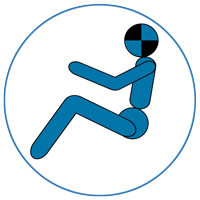This title includes the technical papers developed for the 2021 Stapp Car Crash Conference, the premier forum for the presentation of research in impact biomechanics, human injury tolerance, and related fields, advancing the knowledge of land-vehicle crash injury protection.
Topics covered in this issue include:
- Machine Learning Based Model for Predicting Head Injury Criterion (HIC)
- Investigating Combined Thoracic Loading Using the Elderly Female Dummy (EFD)
- Passenger Injury Analysis Considering Vehicle Crash after AEB Activation
- Factors Affecting Child Injury Risk in Motor-Vehicle Crashes
- A Sensor Suite for Toeboard Three-Dimensional Deformation Measurement During Crash
- Brain Strain from Motion of Sparse Markers
- Short Communications
-
Quantifying the Effect of Pelvis Fracture on Lumbar Spine Compression during High-rate Vertical Loading David R. Barnes — SURVICE Engineering Co. Narayan Yoganandan, Jason Moore, John Humm, and Frank Pintar — The Medical College of Wisconsin Kathryn L. Loftis — U.S. Army DEVCOM DAC Abstract Fracture to the lumbo-pelvis region is prevalent in warfighters seated in military vehicles exposed to under-body blast (UBB). Previous high-rate vertical loading experimentation using whole body post-mortem human surrogates (PMHS) indicated that pelvis fracture tends to occur earlier in…
-
Pedestrian Detection before Motor Vehicle Moving Off Maneuvers using Ultrasonic Sensors in the Vehicle Front Yasuhiro Matsui — National Traffic Safety and Environment Laboratory, Japan Shoko Oikawa — Tokyo Metropolitan University Abstract Vehicles that start moving from a stationary position can cause fatal traffic accidents involving pedestrians. Ultrasonic sensors installed in the vehicle front are an active technology designed to alert drivers to the presence of stationary objects such as rigid walls in front of their vehicles. However, the ability of such sensors to detect…
-
Instantaneous Brain Strain Estimation for Automotive Head Impacts via Deep Learning Shaoju Wu, Wei Zhao, and Songbai Ji — Department of Biomedical Engineering, Worcester Polytechnic Saeed Barbat — The Ford Company Jesse Ruan — Tianjin University of Science and Technology Abstract Efficient brain strain estimation is critical for routine application of a head injury model. Lately, a convolutional neural network (CNN) has been successfully developed to estimate spatially detailed brain strains instantly and accurately in contact sports. Here, we extend its…
-
THOR-05F Response in Sled Tests Inducing Submarining and Comparison with PMHS Response Corridors Olivier Richard — Faurecia Automotive Seating Matthieu Lebarbé and Jérôme Uriot — CEESAR Xavier Trosseille and Philippe Petit — LAB PSA Peugeot-Citroën Renault Z. Jerry Wang — Humanetics Innovative Solutions Ellen Lee — NHTSA Abstract The Test Device for Human Occupant Restraint (THOR) is an advanced crash test dummy designed for frontal impact. Originally released in a 50th percentile male version (THOR-50M), a female 5th version (THOR-05F) was prototyped in 2017 (Wang…
-
Analysis of Lap Belt Fit to Human Subjects using CT Images Yoshihiko Tanaka, Atsushi Nakashima, Haijie Feng, and Koji Mizuno — Nagoya University Minoru Yamada, Yoshitake Yamada, Yoichi Yokoyama, and Masahito Jinzaki — Keio University School of Medicine Abstract In vehicle collisions, the lap belt should engage the anterior superior iliac spine (ASIS). In this study, three-dimensional (3D) shapes of bones and soft tissues around the pelvis were acquired using a computed tomography (CT) scan of 10 male and 10 female…
-
Self-reported Non-nominal Sitting in Passengers is Influenced by Age and Height Adam D. Goodworth and Jeremiah Canada — Westmont College Abstract Automotive safety devices, such as airbags and seatbelts, are generally designed for optimal performance when occupants adopt a “nominal” upright anatomical sitting position. While a driver’s sitting behavior is largely influenced by the requirements of driving, a passenger may adopt any number of non-nominal positions and behaviors. Very few studies have investigated the behaviors that teen and adult passengers actually…
-
Occupant-Based Injury Severity Prediction Susan H. Owen and Jeffrey W. Joyner — Global Product Safety & Systems, General Motors Peng Zhang and Stewart C. Wang — University of Michigan International Center for Automotive Abstract Road traffic injuries continue to be a leading cause of death around the world. Rapid emergency response is a key factor in improving occupant outcomes. Over the past ten years, Injury Severity Prediction (ISP) models have been developed and deployed…
-
Lives Saved by Accelerating the Implementation of Vehicle Safety Technology in New South Wales Johan Strandroth — Strandroth Inc, Lösningar Pty Ltd Ralston Fernandes, Greer Banyer, and Antonietta Cavallo — Transport for New South Wales, Centre for Road Safety Abstract Australian vehicle standards are governed nationwide by the Australian Design Rules (ADR) that specify regulatory standards for the safety performance of road vehicles. The aim of this study was to quantify the number of lives saved on New South Wales roads by accelerating the…
Publisher: The Stapp Association
Specs: Published by The Stapp Association with a Product Code of B-STAPP2021, ISBN of 978-0-9911333-8-3, ISSN of 1532-8546, and 221 pages in a softbound binding
